Great choice! Your favorites are temporarily saved for this session. Sign in to save them permanently, access them on any device, and receive relevant alerts.
- Sailboat Guide
Melges 24 is a 24 ′ 0 ″ / 7.3 m monohull sailboat designed by Reichel/Pugh Yacht Design and built by Devoti Sailing and Melges Performance Sailboats starting in 1993.

Rig and Sails
Auxilary power, accomodations, calculations.
The theoretical maximum speed that a displacement hull can move efficiently through the water is determined by it's waterline length and displacement. It may be unable to reach this speed if the boat is underpowered or heavily loaded, though it may exceed this speed given enough power. Read more.
Classic hull speed formula:
Hull Speed = 1.34 x √LWL
Max Speed/Length ratio = 8.26 ÷ Displacement/Length ratio .311 Hull Speed = Max Speed/Length ratio x √LWL
Sail Area / Displacement Ratio
A measure of the power of the sails relative to the weight of the boat. The higher the number, the higher the performance, but the harder the boat will be to handle. This ratio is a "non-dimensional" value that facilitates comparisons between boats of different types and sizes. Read more.
SA/D = SA ÷ (D ÷ 64) 2/3
- SA : Sail area in square feet, derived by adding the mainsail area to 100% of the foretriangle area (the lateral area above the deck between the mast and the forestay).
- D : Displacement in pounds.
Ballast / Displacement Ratio
A measure of the stability of a boat's hull that suggests how well a monohull will stand up to its sails. The ballast displacement ratio indicates how much of the weight of a boat is placed for maximum stability against capsizing and is an indicator of stiffness and resistance to capsize.
Ballast / Displacement * 100
Displacement / Length Ratio
A measure of the weight of the boat relative to it's length at the waterline. The higher a boat’s D/L ratio, the more easily it will carry a load and the more comfortable its motion will be. The lower a boat's ratio is, the less power it takes to drive the boat to its nominal hull speed or beyond. Read more.
D/L = (D ÷ 2240) ÷ (0.01 x LWL)³
- D: Displacement of the boat in pounds.
- LWL: Waterline length in feet
Comfort Ratio
This ratio assess how quickly and abruptly a boat’s hull reacts to waves in a significant seaway, these being the elements of a boat’s motion most likely to cause seasickness. Read more.
Comfort ratio = D ÷ (.65 x (.7 LWL + .3 LOA) x Beam 1.33 )
- D: Displacement of the boat in pounds
- LOA: Length overall in feet
- Beam: Width of boat at the widest point in feet
Capsize Screening Formula
This formula attempts to indicate whether a given boat might be too wide and light to readily right itself after being overturned in extreme conditions. Read more.
CSV = Beam ÷ ³√(D / 64)
Embed this page on your own website by copying and pasting this code.
- About Sailboat Guide
©2024 Sea Time Tech, LLC
This site is protected by reCAPTCHA and the Google Privacy Policy and Terms of Service apply.
- New Sailboats
- Sailboats 21-30ft
- Sailboats 31-35ft
- Sailboats 36-40ft
- Sailboats Over 40ft
- Sailboats Under 21feet
- used_sailboats
- Apps and Computer Programs
- Communications
- Fishfinders
- Handheld Electronics
- Plotters MFDS Rradar
- Wind, Speed & Depth Instruments
- Anchoring Mooring
- Running Rigging
- Sails Canvas
- Standing Rigging
- Diesel Engines
- Off Grid Energy
- Cleaning Waxing
- DIY Projects
- Repair, Tools & Materials
- Spare Parts
- Tools & Gadgets
- Cabin Comfort
- Ventilation
- Footwear Apparel
- Foul Weather Gear
- Mailport & PS Advisor
- Inside Practical Sailor Blog
- Activate My Web Access
- Reset Password
- Customer Service

- Free Newsletter

What You Can Learn on a Quick Test Sail

Cabo Rico’s Classic Cutter

Bob Perrys Salty Tayana 37-Footer Boat Review

Tartan 30: An Affordable Classic

Preparing Yourself for Solo Sailing

Your New Feature-Packed VHF Radio

Preparing A Boat to Sail Solo

Solar Panels: Go Rigid If You have the Space…

When Should We Retire Dyneema Stays and Running Rigging?

Rethinking MOB Prevention

Top-notch Wind Indicators

The Everlasting Multihull Trampoline

Taking Care of Your 12-Volt Lead-Acid Battery Bank

Hassle-free Pumpouts

What Your Boat and the Baltimore Super Container Ship May Have…

Check Your Shorepower System for Hidden Dangers

Waste Not is the Rule. But How Do We Get There?

How to Handle the Head

The Day Sailor’s First-Aid Kit

Choosing and Securing Seat Cushions

How to Select Crew for a Passage or Delivery

Re-sealing the Seams on Waterproof Fabrics

Waxing and Polishing Your Boat

Reducing Engine Room Noise

Tricks and Tips to Forming Do-it-yourself Rigging Terminals

Marine Toilet Maintenance Tips

Learning to Live with Plastic Boat Bits
- Sailboat Reviews
Early indications are that the carbon fiber-loaded Melges 24 is the next hot one-design keel boat, but its price may discourage some would-be stars.
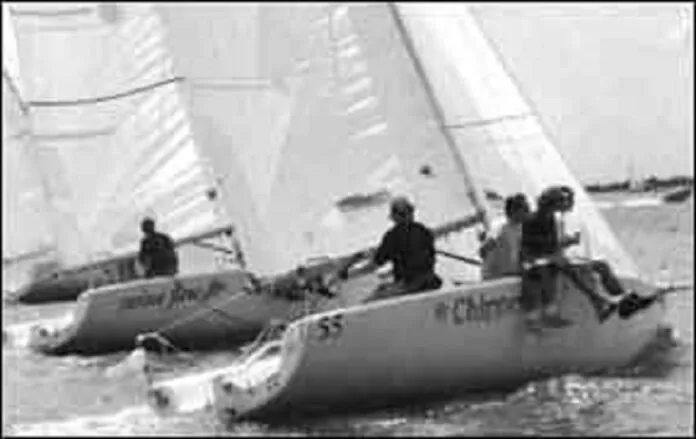
If sailboats were defined in human terms, the Melges 24 could easily be described as having the attributes of a precocious three-year-old who hadn’t learned to respect her elders. More than likely, she also would be described as being gifted, if a little high strung.
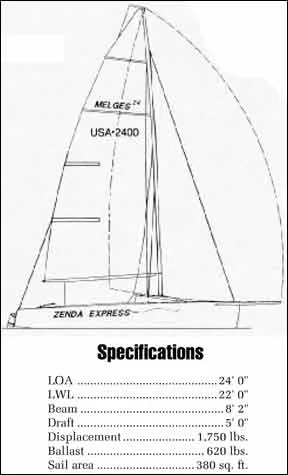
Introduced as a prototype at Key West Race Week barely three years ago, the Melges 24 has already created the same sensation in the small boat performance world as the J/24 when it was first introduced. We’re not suggesting that we should commence composing the epitaph for the J/boat, especially since hull number 5,500 was launched recently and sales are still strong, but we are preparing ourselves for a high noon, main street shoot-out between the aging sharpshooter and the young gun as they wrangle for ownership of the small-boat race market.
Let’s set the stage: In the mid-seventies, Ron Moore began building the George Olson-designed Moore 24, one of the first in the breed of ultra-light, ultra-fast boats produced in Santa Cruz. On the opposite coast, Rob Johnstone introduced the J/24 in Newport, Rhode Island, and another in a series of dramatic changes in the industry was underway.
In addition to having the handling characteristics of a dinghy, these new boats carried tall rigs and moderate sail plans, so were especially fast off the breeze. They were easy to rig at the dock, trailerable, well built, and the hulls were enclosed, so they had at least some interior accommodations and could not swamp. These attributes led to their quick acceptance in the sailing world by a new generation of sailors for whom performance is a religion, and by sailors who had tired of hanging overboard on a trapeze. When the dust settled, the J/24 had captured the marketplace, spawning a revolution that resulted in 60-boat fleets racing at major regattas all over the world.
The Boat and the Builder
Meanwhile, in the backwoods of Wisconsin, the Melges family continued a tradition of manufacturing boats for sailors in the heartland—people who sail scows through the water during the summer, then race iceboats on top of the water during the winter.
Harry Melges of Zenda opened the Melges Boat Works in 1945, carving a reputation as a major builder of scows, although he also constructed boats ranging in size from 12-foot marsh skiffs to moderately priced 30-foot cruisers. The company also builds sails for the boats it manufacturers. Son Harry, Jr., nicknamed Buddy, joined the operation during his teen years, and while honing his boatbuilding skills he also set about building a reputation as one of the finest sailors in the country. He eventually attained international prominence by winning a gold medal in sailing in the 1972 Olympics. Following an unsuccessful attempt to campaign his own boat in the 1987 America’s Cup, he joined Bill Koch as coskipper for the America3 effort in 1992, a fortuitous choice that played a major part in the development of the Melges 24. In his absence, sons Hans and Harry III assumed responsibility for operation of the company, and began hatching plans for a new performance boat.
“The twenty-four was actually Hans’ idea because he was convinced there was a market for a new boat in that size range,” Buddy admits. With input from Hans, the designers of Koch’s three America’s Cup boats, Jim Pugh and John Reichel, began the process of designing a pocket rocket that piggybacked many of the characteristics of that $64 million dollar project. “I’d throw in a suggestion here and there, but Hans deserves credit for its development,” Melges adds.
The first prototype for the 24 was completed in time for Key West Race week in January, 1993, when John Kostecki sailed it into the winner’s circle.
“That first regatta provided the opportunity to test the design, and we learned that the boat was fast enough,” Hans recalls. “We sailed in very windy conditions and heavy seas so we tested our construction methods as well. When we took the boat back to the factory and gave it a thorough examination, we only found a couple of areas that needed improvements, which we made before we started production.”
By the end of 1994, 250 boats had been delivered in the United States, and Melges had entered into a joint venture with British Aerospace for production of the boats in Europe. One-design fleets have spawned across the country, and the fleet overwhelmed Race Week in January, 1995, with 63 entries.
Design and Deck Layout
Three of the characteristics that attracted boaters to the J/24 incited the Melges revolution: They are fast upwind and really fast downwind, well constructed, and trailerable. Because the new boat benefits from 15 years of design and construction improvements, comparisons to the J/24 are almost unfair, but do provide a frame of reference. For example: The J/24 is 20 feet on the waterline, weighs 3,100 pounds, carries 950 pounds of ballast, and flies 263 square feet of sail under a jib, 476 under spinnaker. Under PHRF, the J/24 typically rates in the 170s. By comparison, the Melges is 22 feet on the waterline, displaces only 1,750 pounds, carries 620 pounds of ballast in a bulb keel, and flies 380 square feet of sail under the jib, and 920 under the spinnaker. Its displacement/length ratio is 73, the sail area/displacement ratio is 41.8, and it rates in the 90s under PHRF.
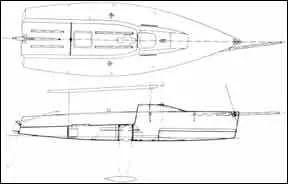
Aside from its plumb bow, narrow beam, flat bottom, hard bilges and open transom, one of the most striking features of the boat’s design is the enormous, 13-foot long cockpit, designed to allow crew to move quickly from side to side during tacks, and to position weight in pre-determined spots to maximize boat speed off the breeze.
The 6-lb. carbon fiber tiller extends into the cockpit to a point just aft of the mainsheet, which is housed on Harken track mounted on 3-inch risers on the cabin sole. When going to weather, the driver steers by using a 40-inch Ronstan tiller extension that allows positioning in front of the traveler while trimming the mainsheet and handling backstay tension. The mainsheet is led through a 3-inch Harken Hexaratchet and cam cleat.
Tacking requires some acrobatics, one of the few shortcomings on the boat, since the driver must step aft, around the mainsheet, which can result in a loss of control of the sheet, or step forward, which results in a temporary loss of tiller control.
Since the boat has no winches, a double-ended sheet is led from the jib through cars mounted on a track inboard of the shrouds, then aft to 3-inch Harken ratchet blocks that provide controls for upwind trimming. The boat is sailed with an asymmetrical spinnaker tacked to a bowsprit, so a similar arrangement is utilized for spinnaker sheets. However, since four crewmembers and all of the sheets seem to be concentrated in the center of the cockpit, we’d recommend the purchase of mesh sheet bags. The hull-deck joint and cockpit surfaces are smooth and well-radiused, so the crew is fairly comfortable when hiked out, especially compared to boats that require maneuvering around winch pods and seats on uncomfortable toerails when hiking. The absence of toerails, of course, creates certain risks. A single lifeline, stanchions and stern pulpit are included in the base price of the boat.
Melges has developed a clever way of dealing with storage of the outboard and the cooler. A lazarette in the cockpit sole accesses an 18-inch deep storage area that extends to each side of the hull and from the companionway aft to a bulkhead. A tray mounted on rails beneath the opening provides storage space for a 3-hp. outboard motor, which slides forward so it doesn’t clutter space below decks, and its weight is more strategically located. When it’s time for refreshments, a cooler mounted on rails slides forward into the opening in the sole. The fuel tank also fits in the storage area.
Forward of the cockpit, things are fairly straightforward, although this is the first boat we’ve sailed that includes a bicycle pump as standard equipment. In lieu of a topping lift, a pneumatic, anodized aluminum Melges vang supports the boom and allows for height adjustment by varying air pressure. The outhaul exits the boom and is led through a block to a clam cleat mounted on the bottom of the boom so it can be tensioned from either side of the boat. The spinnaker halyard exits the aft edge of the mast into a cam cleat located just below the gooseneck.
One of the keys to the boat’s performance is a deck-stepped carbon fiber mast, manufactured in Minden, Nevada by Omohundro. Use of carbon provides plenty of strength, and reduces the weight of the spar and swept-back spreaders to only 62 pounds, a savings of approximately 25 percent, compared to aluminum. The roach of the main is large enough that the first boats produced were plagued by the sail hooking on the backstay when tacking in light airs so a mast crane now suspends the backstay clear of the sail. Similarly, concerns of excessive mast twist when sailing downwind were solved by the design of a fitting shaped like a “PacMan,” which attaches the crane to the mast and allows a modest amount of mast twist when under load. The mast is supported by 1 x 19 stainless steel uppers and lowers. Shrouds are tensioned by calibrated Ronstan turnbuckles. The tapered aluminum boom is fabricated in the Melges shop.
The headstay is a 3/16-inch wire that is inserted into the luff of the jib when preparing for sailing, so it doubles as the jib halyard. From the tack in a recessed Harken roller furler, the halyard runs the length of the jib luff to the masthead, from whence it is led internally to a turnbuckle located below decks. Once proper jib halyard tension is achieved, a Highfield-type lever mounted on the mast compression tube is closed to secure the arrangement.
The 6-foot long retractable carbon fiber bowsprit is mounted to starboard in the bow, where it is enclosed in a specially designed self-lubricating, neoprene seal designed to prevent water from intruding into the boat. Below deck, the bowsprit slides through supports in gussets mounted in the hull. The sprit is extended and retracted by pulling a line running from the tack below decks to the cockpit, where it is cleated on blocks attached to the inside wall of the coachroof.
As you would expect in a special-purpose boat, accommodations are spartan at best, and there’s little headroom. The mast compression post is located in the center of the cabin, the bowsprit extends aft almost to the bulkhead, and the spinnaker bag is attached to port, so there’s little room for movement. Though the forepeak is 6′ 5″ long, and quarterberths are long enough for a small person, prospects of camping on the boat aren’t particularly appealing. There’s adequate space for a portable toilet, and storage areas are located amidships and in aft quarters. Since the boat has no internal flotation, these bins could be filled with flotation material for those desiring a higher level of security. Some owners have added running lights and a KVH Sailcomp package, which necessitates the purchase of an electrical panel located on the coachhouse, and gel-cell battery housed in a storage area near the mast.
Construction
The hull and deck are cored with Klegecell foam; the skins are S-glass and biaxial fiberglass pre-impregnated with vinylester resin. A vacuum-bagging process assures a better laminate with fewer voids and more favorable glass-to-resin ratios. The hull and deck are handlaid in molds that Hans says result in one-mil tolerances. Bonding of the two structures is accomplished by application of a proprietary two-part adhesive system. There are no mechanical fasteners. (We have previously reported that TPI has been doing essentially the same thing in its Lagoon catamarans.)
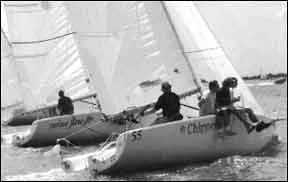
The tiller and rudder are carbon fiber, the latter hung from the stern on stainless pintles and gudgeons manufactured by Melges. The keel is also carbon fiber, made by Omohundro. The bulb is lead. Both are nicely faired. Raising and lowering the keel is accomplished by attaching a wire attached to a gantry that fits into the cockpit to a stainless eye that screws into the top of the keel. Vertical Delrin guides are located on the side of the keel and fit snugly into similar bracing in the keel trunk. This assures that there is no keel movement when underway. Once lowered, the keel is secured by Kevlar straps buckled to the hull and covered by a fiberglass cover screwed flush to the cockpit sole. A unique feature of the design is a kelp cutter built into the front of the keel, a stainless blade attached to a rod that is operated by lifting a small knob in the cockpit sole.
Overall, the finished product reflects the manufacturer’s skill and attention to detail. For example, HI-200 and G-10 (high-tech, workable plastics) are used for backing plates and core replacement in areas requiring reinforcement.
Performance
The boat proved easy to launch. With assistance from Tim Carlander of VMG Marine in Seattle, we had the mast up, the boat rigged and were headed for the launch ramp 30 minutes after arriving. Hoisting the mast is accomplished by placing horns located on the foot of the mast into a bracket on the deck, attaching the spinnaker halyard to the trailer winch, and ratcheting the halyard as a crewmember elevates the spar by walking the length of the cockpit. We had the main up and the jib unfurled minutes after sailing away from the dock, and reached hull speed sailing on a beat in flat waters across Lake Union. Though sensitive to movement afloat, the boat felt solid. We learned quickly that driving takes practice; because the boat is so responsive we over-steered our first tack and finished with an accidental jibe. Similarly, we learned that tap-dancing around the mainsheet takes practice. Though the boat is sensitive to the crew’s movements, it tracks well, a function of the deep 5-foot draft and the keel bulb.
Because the asymmetrical, masthead chute was tacked to the pole before we left the dock, the set was a simple matter of hoisting the halyard and watching the sail exit a mesh bag attached with hook-and-loop strips to the companionway. We experimented by sailing on different angles and determined that the boat is fastest and most responsive when sailing high jibe angles, although we also sailed wing on wing significantly faster than a conventional boat with a drifter. Though we sailed quickly in a moderate breeze, it’s easy to imagine the 20-knot speeds recorded by racers in 15-20 knot winds.
Jibing takes some practice. Because the boat is not sailed with a spinnaker pole, the sheet must be eased quickly when the jibe begins, and the new sheet trimmed quickly, or the boat decelerates and the spinnaker wraps around the headstay. After three practice jibes we had the routine down, but would want more practice in heavier winds. Dousing is accomplished by gathering the sail as the halyard is eased, then releasing the tack and securing the sail in the bag. Re-hoisting can be accomplished in seconds.
Since our sail, Melges has developed a spinnaker bag with a fiberglass frame and canvas lid that fits over the companionway, an improvement that avoids the necessity of closing the hatch cover in heavy seas.
Sailing in non-racing conditions, we had the luxury of sorting things out slowly as we advanced up the learning curve. However, it’s apparent that layout and operation of the boat have benefited greatly from Reichel-Pugh’s input. New skippers and crews should be sailing the boat to speeds close to its polars as quickly as they devote the time to sort things out.
In our opinion, the basis of any evaluation of the Melges 24 starts with the understanding that this boat is about performance and shouldn’t be compared to boats having nicer accommodations and amenities. It’s going to provide thrilling, high-speed sailing, more than a J/24, for instance, and is probably best suited to experienced sailors. Early indications are that winning in this class will also reflect a high degree of sailing skill among the crew. When sailed in PHRF fleets in flat waters and moderate winds, the boats have proven their ability to collect trophies while defeating larger boats with similar or lower ratings.
With a 50-year history of building boats, and rapid responses to changes they felt necessary in the 24, the Melges family seems to have made a commitment to quality. Their design and construction techniques appear to be top notch and customer service is responsive. It’s hard to imagine being shortchanged from that standpoint.
With a base price of $34,500 for the boat, an additional $3,200 for a trailer, plus sails ($3,500-4,500), motor and other optional equipment, it’s easy to visualize a total expenditure of $48,000 or more. This price compares to a recently advertised “special” price of $29,400 for a new J/24 and trailer, or $29,900 for the Tripp 26 (see February, 1995) which rates approximately 110-115 under PHRF. Clearly there’s a premium to pay for all the carbon fiber, but that is the technology of today, and if you want to be at the leading edge, you need it.
Sailors take two points of view when evaluating the price of the boat, which is in the upper levels of the sport boat marketplace: One dismisses the boat as being too pricey, period. Others divide the cost by the rating and determine that, compared to bigger boats with a similar handicap, this may be a bargain, since it is trailerable, sailed with fewer people, has rigid class rules, is less complicated, and won’t be as expensive to repair when things break.
RELATED ARTICLES MORE FROM AUTHOR
Leave a reply cancel reply.
Log in to leave a comment
Latest Videos

Buying A Sailboat Is Scary! Yacht Broker Interview

The Great Loop – The Basics

Bottom Paint Showdown – Six Paints, One Winner!

Tartan 30 | Boat Review
- Privacy Policy
- Do Not Sell My Personal Information
- Online Account Activation
- Privacy Manager
The Melges 24 is a 24.0ft fractional sloop designed by Reichel/Pugh and built in fiberglass by Melges Performance Sailboats since 1993.
The Melges 24 is an ultralight sailboat which is a very high performer. It is stable / stiff and has a low righting capability if capsized. It is best suited as a racing boat.
Melges 24 for sale elsewhere on the web:

Main features
Login or register to personnalize this screen.
You will be able to pin external links of your choice.

See how Sailboatlab works in video

We help you build your own hydraulic steering system - Lecomble & Schmitt
Accommodations
Builder data, modal title.
The content of your modal.
Personalize your sailboat data sheet
Sailboat specifications
- Last update: 20th March 2020
Melges 24's main features
Melges 24's main dimensions, melges 24's rig and sails, melges 24's performances, melges 24's auxiliary engine, melges 24's accommodations and layout.

Similar sailboats that may interest you:
The Worldwide Leader in Sailmaking
- Sail Care & Repair
- Sailing Gear
- Sail Finder
- Custom Sails
- One Design Sails
- Flying Sails
- New Sail Quote
- 3Di Technology
- Helix Technology
- Sail Design
- NPL RENEW Sustainable Sailcloth
- Sailcloth & Material Guide
- Polo Shirts
- Sweaters & Cardigans
- Sweatshirts & Hoodies
- Accessories
- Mid Season Sale
- Mid & Baselayers
- Deckwear & Footwear
- Luggage & Accessories
- Spring Summer '24
- Sailor Jackets
- Maserati X North Sails
- NS x Slowear
- Sailor Jacket
- Sustainability
- North Sails Blog
- Sail Like A Girl
- Icon Sailor Jacket
- Our Locations
- North SUP Boards
- North Foils
- North Kiteboarding
- North Windsurfing
SAIL FINDER
SAILING GEAR
COLLECTIONS & COLLAB
WE ARE NORTH SAILS
ACTION SPORTS
Popular Search Terms
Collections
Sorry, no results for ""
MELGES 24 SPEED GUIDE
Class leader Brian Janney answers your Melges 24 speed and boathandling questions.
Who sails in the Melges 24 class?
In the early 2000s, sailors in the Melges 24 class began to enlist coaches and include professional sailors in their crews, but that trend collapsed and participation dropped way off after 2009. Gradually, the class has been growing again and we are seeing an increasing number of Corinthian teams sailing at major events, using older boats. Local fleets are coming back in North America also, in places such as Vancouver, Western Michigan, and Atlanta. There are more regional regattas on the schedule, and they are by nature much more Corinthian. (Learn more at the International and North American class websites.)
How physical is the Melges 24 to sail?
The Melges 24 is a great boat if you like to be active when you sail. It requires athleticism, but not brute strength. The loads are not that high and there are no winches—ratchet blocks only. You have to hike hard, but since the class changed to shorter stanchions and tighter lifelines, hiking is less painful. Overall, it’s a good combination of keelboat and dinghy. In light air, it rewards roll tacking and jibing, but in heavy air it loads up like a keelboat and you have to think about the timing of your maneuvers.
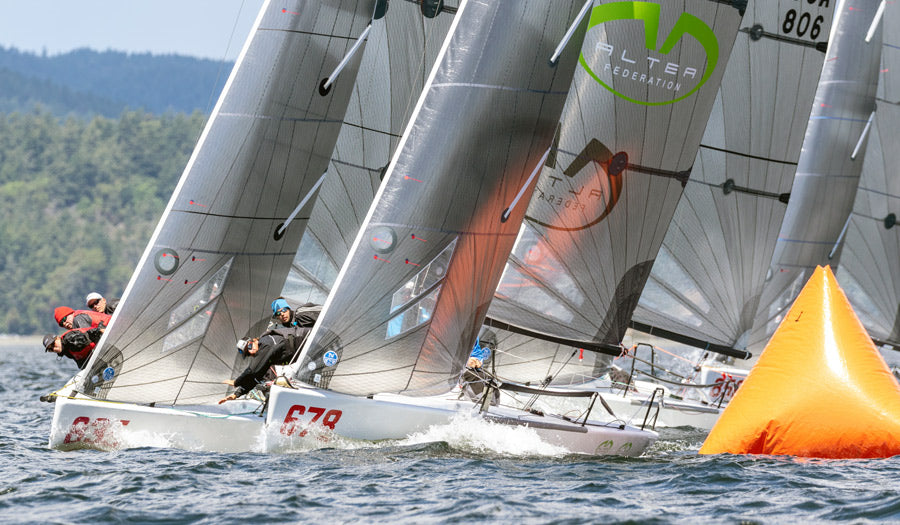
Athletic sailing is the norm for Melges 24 crews, shown here after a start at the 2018 Melges 24 World Championship. Piret Salmistu/IMCA photo
What are the top 3 ingredients to compete successfully in the Melges 24?
- Practice mark roundings—good sets and douses are key.
- Practice light-air downspeed maneuvers—the pre-start under main alone is key.
- Build a consistent crew—top performance is all about teamwork.
What is the ideal Melges 24 crew size?
Top teams sail at the max weight limit of 825 pounds (375 kilograms). The majority sail with five in the crew. Larger people sail with four.

Crews sail with four or five to meet the crew weight maximum of 825 pounds.
What does each crewmember do on the Melges 24?
The helm drives and handles mainsheet and backstay. The tactician trims the jib upwind and sometimes handles the mainsheet downwind. The spinnaker trimmer hikes upwind and hoists the chute if they are the biggest crewmember. On a boat sailing with five, the two forward crew furl the jib, douse the spinnaker, and handle the tack line and pole.
On boats sailing with four crew, the forward crew handles the tack line, jib furl, and spinnaker hoist/retrieval.
The tactician pulls the pole out and then grabs the spinnaker sheet, handing it off to the trimmer once the halyard is up.
New or used Melges 24s— what are my options?
A new Melges 24 costs in the $70,000 range and includes a trailer, covers, and an upgraded line package. The company periodically builds runs of four or five boats. As of 2018, hull numbers ran up to about #900. Used boats range from a 1990s boat for less than $20,000 to somewhat newer boats with covers and a trailer with dock boxes for about $30,000.
Beyond the basics, what kind of prep is needed to make a used boat competitive?
Older boats may need mast-step reinforcement or repair of stanchion bases. They may also need the new, shorter stanchions. The Melges 24 has a carbon-fiber rudder and keel. Look for a boat without dings in the foils, or be prepared to make repairs. We keep a close eye on the trailing edges of keel and rudder. When we trailer the boat, we pad the back of the keel with a pool noodle we’ve cut in half. Check for wear on normal gear as well, such as cam cleats.
The jib halyard system is unique and needs attention on all boats.
Instead of the usual separate forestay and jib halyard, the halyard connects to the wire in the luff of the jib, which then serves as the forestay. Where the wire goes over the halyard sheave, it can break strands on a windy day, so we recommend checking it after every windy day of sailing and replacing the wire frequently.
How do you transport the Melges 24?
Melges 24 trailers come from the builder with shaped supports. The boat rides about five feet off the road, at shoulder height. You put the boat in the water with the keel in the “up” position and then lower it with a “keel crane,” which fits into a molded socket right behind the keel. You can also ramp launch the boat if you wish.
What's involved in rigging and derigging the Melges 24?
To rig the Melges 24, first attach the shrouds, spreaders and backstay, then pull the halyards down from the top of mast. Because the mast is deck-stepped, two people can raise it. Rig the spinnaker halyard forward so it acts like a temporary forestay. A team that knows the process can be ready to launch within an hour. Once you’re in the water, put the keel down, fasten down the cover plate, and attach the rudder. There is a small gas outboard, so once that’s in position, you’re ready to go.
What kind of inventory does North recommend?
North offers the championship-winning 3Di mainsail and jib. There are two spinnaker designs, a reacher and a runner. You are allowed to carry two spinnakers, and most top teams will have one of each aboard. The reacher is used in planing conditions when you’ll spend more time sailing in a “bow up” mode. The runner was recently redesigned to be a bit twistier, allowing a larger crossover with the reacher.
Melges 24 Tuning
What are the most important ways to tune the melges 24 rig.
Tuning the rig is described in detail in the North Melges 24 Tuning Guide . The key parameters are rake and shroud tension. Because the spreaders are swept aft, as you add tension to shrouds, the mast bends and becomes raked more. Unlike some classes, you’re allowed to adjust the shrouds while sailing; knowing the number of turns for each setting, the forward crew can make the adjustments while hiking. From the base setting to 20 knots, it’s 20 turns. Top boats have shifted to open-body turnbuckles because they’re twice as fast to adjust and easy to pin using a piece of batten held in place with shock cord.

This is the shockcord/batten for quick adjustment of turnbuckles. Photo courtesy APS
What are the key steps to setting up the rig?
The first step is to hoist the internal jib wire and set the rake at the turnbuckle above the Highfield lever. Rake is measured
from the top of the mast to the intersection of the transom and the bottom of the hull. This measurement should be 36’6.5” (11.140m).
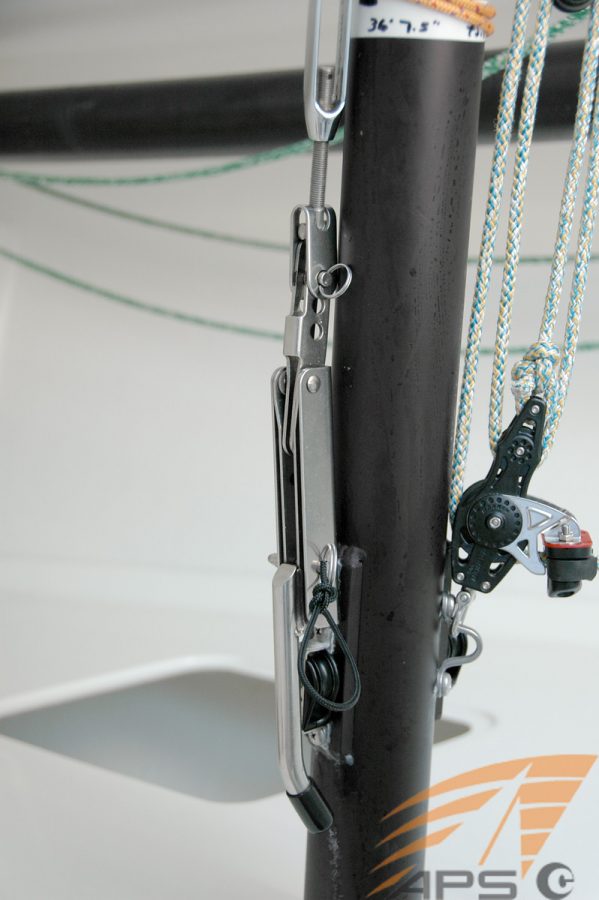
Next, add shroud tension until it is 16 on the Loos gauge. You may have to adjust the turnbuckle above the Highfield lever to maintain the proper rake adjustment. It helps to have two people to do this.
Are there other special considerations when setting up a Melges 24?
It’s easy to scratch or damage the keel when hauling and launching. The North Tuning Guide includes what to watch for there, as well as several tricks to marking control lines and setting up your deck.

Melges 24 Upwind Sailing
Upwind, where does the melges 24 crew sit.
The normal or “base” crew position starts with the bow person a half-body width aft of the forward stanchion; all others sit close to the person in front of them. In light air, push the forward crew right up against the stanchion. As waves pick up, everyone moves aft until the aft crew is right against the aft stanchion. The tactician should be the first person to move off the rail in lighter air, so they can trim the jib and look around.

Even in light winds, the Melges 24's powerful sailplan requires the crew to hike.
What do you focus on when trimming main and jib?
Always watch the top telltale on the jib leech when sailing upwind. You can see it through the mainsail spreader window. The jib sheets are on a 2:1 purchase and go through a ratchet block. Two cleats, one on each side of the cockpit, make it possible to “banjo” the sheet in from the weather rail. Usually we don’t play the jib much.
Most upwind control is done with the main due to its large size. In the puffs, the helm pulls on backstay or drops the traveler. Few helmsman are strong enough to play mainsheet, although one class veteran, Brian Porter, can do it and is very fast. Tighten the backstay to keep the boat on its feet and ease when the puff rolls away. Have your forward crew count down to puffs; it really helps the person driving concentrate on boatspeed. Most boats have speedos now, and the helmsman can’t look around, although they do tell the tactician about traffic to leeward since they are facing inboard.
In 12 knots, your jib telltale can be stalling slightly; as it gets windier, ease the jib out half an inch. The jibs are pretty high aspect, and this will create more twist in the head and allow the telltales to stream more. You can also foot a little more, which increases your lift and helps you point.

Hiking as a team upwind in a breeze is vital in the lightweight Melges 24. Piret Salmistu/IMCA photo
Going upwind, how should the top telltale look on the Melges 24 mainsail?
The mains carry quite a bit of twist. In lighter air you’ll close the top of the main for power, but in 10 knots you’re close to overpowered so the top telltale should be streaming. Your helm should be light, nearly neutral, so if you make a change and it gets out of balance, you can tell right away.
What other trim settings should you look for upwind on the Melges 24?
Pay attention to shroud tension. My rule of thumb is to have 75 percent of the backstay on from 12 knots and up. The backstay purchase is at the feet of the helmsman and most people use a number scale on the deck behind that. If you are easing off a lot on the backstay, that means you need to ease shroud tension. If you are close to maximum backstay tension, try tightening the shrouds. We have our tactician watch for that, too.
Who is in the typical dialogue loop and what's a typical conversation?
Probably the most important upwind dialogue is a countdown to puffs—that’s key for the driver. If you don’t depower, the boat will tip over and do a little roundup.

In a good breeze downwind, a top crew slides aft and extends arms and torso outboard to maximize leverage. Piret Salmistu/IMCA photo
Melges 24 Downwind Sailing
Where does each person sit when sailing the melges 24 downwind.
In lighter air, which we call “soak mode,” everybody pushes forward to get the transom out of the water. The tactician and one bow person are to leeward; everyone else sits to weather. As the breeze comes up, everyone moves to the high side and begins to slide aft. When the boat is on a full plane, everyone except the trimmer moves behind helmsman.

In light air downwind, the crew consolidates their weight at the forward end of the cockpit, with one crew to leeward in front of the chainplates.
What do you focus on when trimming the main and other sails?
The Melges 24 starts planing at about 14 knots, flying all three sails. We call it “lazy planing mode.” Everyone is pushed back against the aft stanchion, hip to hip. As the breeze comes up, move one person behind the stanchion; then move others aft as needed..
In most conditions, trim with a slightly firmer spinnaker luff—not over-trimmed, but not a lot of curl. In light air, ease the sheet and begin to “test” the curl a bit more. As you start planing, you have to trim in as the wind goes forward. Your spinnaker trimmer is sitting down at this point, and your tactician moves aft to trim the mainsheet—at least that’s the norm among tacticians with dinghy backgrounds.
In this Facebook video, the 2018 world champions demonstrate how to sail on a flat-out plane with three sails flying in a strong breeze on Lake Garda (on a day racing was canceled).
What are the key gear shifts in a Melges 24 as wind and sea state change?
The main question downwind is whether you can surf the waves or not. If you can readily plane, sail a couple degrees higher until the Melges 24 takes off. Some people try to force it too quickly and sail a lot of extra distance compared to those who sail lower and slower but cover much less distance. The boats have no wind instruments, so as the breeze builds, those who pick up on this transition first will make huge gains. You need to learn your transition point, which is right at about 14 knots of wind.
Who is in the dialogue loop downwind and what's a typical conversation?
Your spinnaker trimmer and helmsman should always talk about pressure in the spinnaker sheet—typically that means the spinnaker trimmer is talking, or the driver is asking the trimmer what they are feeling. Puff calling is the other key input to the conversation; that should be the same person who was calling the puffs when sailing upwind.
Are there special situations or techniques downwind in the Melges 24?
With the jib unfurled, it takes a little practice to get all three sails across in a jibe. It also requires coordination for the tactician to flip mainsheet over the helmsman’s head at the right time.

On the way to the offset mark, a Melges 24 crew preps the spinnaker to go up (at right) while continuing to hike the boat flat (at left). Piret Salmistu/IMCA photo
Melges 24 Boathandling
What's a typical melges 24 start like.
Starts in the Melges 24 are more like dinghy starts than keelboat starts. Set up early, sail slowly, and jockey for position. Keep the jib furled and try to create a hole to leeward so you can unfurl, sheet in, and go. The boat accelerates quickly.
What makes a big difference on the starting line?
Set a minimum boatspeed, usually 2.5 knots. Any slower, and when you sheet in the boat will go sideways before it goes forward due to lack of flow over the keel. Velocitek speedos are allowed, so assign someone on to watch it and speak up if you’re slowing down too much. Assuming you have pinged the starting line, the Velocitek will also read the distance to the line.
What mistake slows the Melges 24 down most in a tack?
A key mistake is not coordinating how everyone gets off the rail. Hiking out, the crew is sitting hip to hip, so if the first person in doesn’t give others room it’s hard for everyone else to get off the rail. You can get pinned to the rail on a crash tack, which is a great reason to communicate when traffic is coming.
What does each crewmember do in a tack?
Normally, the helmsman handles the traveler and main, and the tactician tacks the jib. The rest of the crew scrambles to cross the boat in good form. The traveler usually stays fairly close to center, but in very light air it needs to move to windward. If the tactician can’t help, ask your smallest person to move behind the tactician and help.
Key tips for good light or heavy-air tacks in a Melges 24?
Making a smooth turn with the helm is important. It’s easy to over-rotate, and you don’t need to come out at a deep angle because the boats accelerate fast. The helm needs practice to learn exit angles. We put a mark on the jib sheet, draw a scale on the deck, and pull it in 90 percent of the way. After hitting the rail to hike out, the tactician leans in as soon as possible to banjo the jib sheet in the rest of the way
What mistake slows the Melges 24 down most in a jibe?
The key move on the jibe is properly rotating the spinnaker. In light air and up until the boat is lazy planing, make sure a forward person grabs the spinnaker sheet and pulls it around the headstay.
Here is a great video of a “blow-through” jibe in strong winds . Note the forward crew, briefly pulling the spinnaker leech in against the jib.
What does each crewmember do in a Melges 24 jibe?
The helm steers, the tactician deals with the mainsheet, the spinnaker trimmer handles both spinnaker sheets, and the forward person or people help overhaul the new sheet. In light air, the keys are to have quick hands on the spinnaker sheet and to come out at a good exit angle, sometimes a little hotter (higher) than you think. In heavy air, hitting the right exit angle is big and you make a slower turn. As you bear away, the helm watches the clew of the chute and pauses until the clew gets around the headstay, then finishes the turn. If the helm turns too fast, the spinnaker may get a wrap.
What is the key to a fast spinnaker set?
Having a good mark on your tack line is critical to a good set on a Melges 24. Preset the tack line at that mark, and then hoist the halyard while the pole is going out. If your tactician sees a wrap starting to happen, they should give the sheet a quick pump and then quickly ease it back out.
Who does what in the Melges 24 crew on a bearway set?
The helm handles the main while the tactician eases the jib sheet and cleats it, and then picks up the spinnaker sheet. The trimmer hoists the spinnaker halyard before taking over the sheet. Of the two forward people, one is to leeward, helping to feed out the spinnaker. They also uncleat the jib sheet and furl the jib when the chute is up. The other person pulls the pole out and eases the vang so you can bear way.
What is the key to a good spinnaker takedown?
We always take down to port on the Melges 24. Also, we usually drop the chute behind the shrouds instead of between the shrouds and the mast. If it’s a weather strip, one bow person overhauls the spinnaker sheet, the same as they would in a jibe. The spinnaker trimmer hauls on the sheet as well. When the forward person has a hand on the cloth, the other forward person releases the pole, then the halyard, then the tackline. Typically the smallest person on the boat is uncleating everything. The trimmer throws the chute into the cockpit and then the smallest person stuffs it below. The two largest people get on the rail!
On a leeward douse, more of a turn-down is required of the helmsman. As soon as we can grab some spinnaker cloth, we say, “Pole in, halyard down, then tack line.” Some people blow the tackline off so the forward part of the sail flags.
Any special tricks to Melges 24 takedowns?
Make sure to unfurl the jib before you start to take down the spinnaker to avoid fouling the spinnaker halyard in the roller-furling swivel aloft.
Doing circles is slow; how do you minimize the pain when you have to spin?
The Melges 24 has lots of mainsheet. The tactician takes the mainsheet from the helm, and the spinnaker trimmer handles the jib. Steer with your weight and backwind the jib if need be to turn the boat through the wind.
How easily does the Melges 24 broach or capsize?
It’s fairly easy to wipe out when you’re planing, especially if you stay too close to the high edge. Typically, if you broach coming out of a jibe, the helmsman turned too quickly, the trimmer had to overtrim the chute, and then when it popped open you were overpowered. To recover, backwind the jib and ease the vang, and the boat should turn back downwind.
What are the most common boathandling mistakes made in the Melges 24?
During the sets, pulling the pole out too quickly can sometimes allow the tack to drop into the water. That’s like setting a very big parking brake. The same thing can happen on the douse—keep the tack out of the water! Also, when jibing in light air, don’t forget that you may need to pop the top battens on the main.
Do you have any suggestions for drills to improve boathandling?
Go out and do loads of tacks and jibes—especially jibes. Practice sailing and maneuvering at low speeds alongside a buoy. See how long you can sit next to it and how much you’ll go sideways before going forward. Your starts will improve.
FEATURED STORIES
North 3di: frequently asked questions, the reason north 3di is a must-have, pursuing perfection: tom gillard and the one design team.
- Refresh page
× You are using an outdated browser. Please upgrade your browser to improve your experience.
We Ship Worldwide! | FREE SHIPPING! for US Continental orders over $99. Click for details.

Shopping Cart
Your cart is currently empty..
FREE SHIPPING! for US Continental orders over $99 click for details
Melges 24 - Sailboat Data, Parts & Rigging

Sailboat data, rig dimensions and recommended sail areas for Melges 24 sailboat. Tech info about rigging, halyards, sheets, mainsail covers and more.
Sailboat Data directory for over 8,000 sailboat designs and manufacturers. Direct access to halyards lengths, recommended sail areas, mainsail cover styles, standing rigging fittings, and lots more for all cruising and racing sailboats.
MAURIPRO Sailing offers a full range of sailboat and sailing information to help you find the correct sailboat part, one that properly would fit your sailboat and sailing style. Our sailor's and sailboat owner support team are ready to talk with you about your specific sailing needs, coming regatta, or next sailing adventure.
From all at MAURIPRO, let's Go Sailing!
Copyright © 2024 MAURIPRO Sailing LLC.

- CLASSIFIEDS
- NEWSLETTERS
- SUBMIT NEWS

Melges 24 European Sailing Series 2024 at Yacht Club Adriaco - Day 1
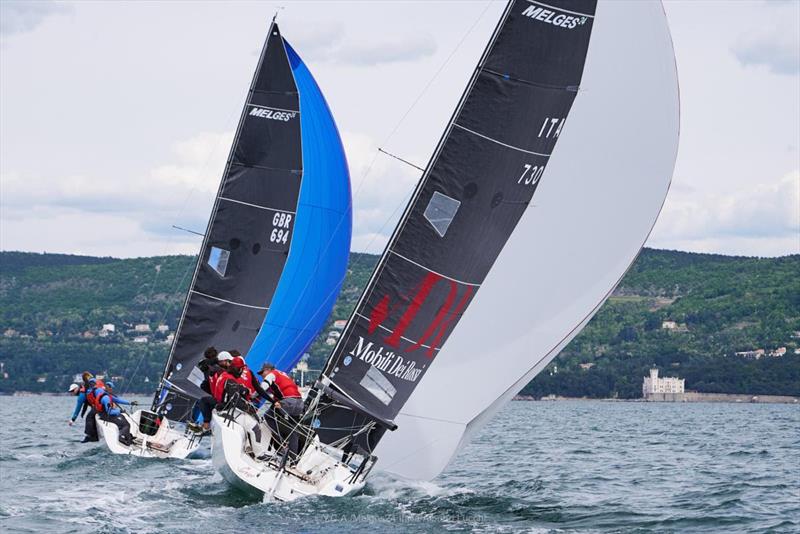
- Provisional Results after 4 races
- Event website & Notice Board
- Day 1 photos © YCA / ITA M24 Class / Alberto Lucchi
Related Articles
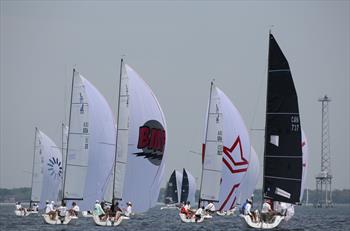

- Melges A Scow
- Melges E Scow
- Melges C Scow
- Melges MC Scow
- Melges X Boat
- O’pen Skiff
- Skeeta & Nikki
- Melges RIB 625C
- Melges Power 26
- About Melges
- Quantum Sails Zenda
- Find a Dealer
- Melges Europe
MELGES SAILBOATS
FUN. MODERN. EASY TO SAIL.
Designed by Botin Partners Naval Architecture and built by Premier Composite Technologies, the Melges 40 is a weapon for windward/leeward, inshore and coastal racing. Fresh off the design line, the Melges 40 strengthens a unique sailing/racing experience.
The Melges 32 ® is one-design racing at its best. Since 2005, it has successfully delivered bigger, better sailing that is fun and competitive. Complementing its sporty attitude, it possesses one of the most fun regatta schedules that includes many prestigious venues supported by an organized and well-established class association.
The reputation of the Melges 24 ® precedes itself. Best known for its very competitive disposition and easy-to-sail personality, this modern sportboat maintains its status as a leader in high-performance, one design yachting. With more than 850 boats sold, it continues a humbling tradition of America's Cup, Olympic Medallists, Volvo Ocean Race recruitment. Looking to improve on tactics and boat handling skills? The Melges 24 builds better sailors.
Simple, fun world-class racing at yachting's most celebrated venues. Corinthians and professionals alike. Year after year, that's what the Melges 20 Experience is all about. The Melges 20 fulfills the need for a more compact, yet spacious, fast, well-built sportboat. With its introduction, Melges Performance Sailboats delivered the next generation of sailboat racing and competition. An exclusive Reichel/Pugh keelboat design, it is advanced in every respect. Made with high-quality materials and easy to rig, the Melges 20 enjoys a well-established worldwide fleet and fan base.
Designed by Reichel/Pugh and built by Melges, the Melges 15 prioritizes stability, comfort, ease of use, and performance. The Melges 15’s stable hull shape and ergonomic cockpit make it a suitable layout for adult racing and educational sailing. Easy conversion from a club configuration (non-spinnaker) to a one-design setup, provides more versatility to club programs and options for individual owners. With the main design goals focused on stability and performance in a variety of conditions, the boat features a narrow overall beam and a flat cross-section shape for stability, righting moment, and ease of planing.
Designed by Reichel/Pugh, the Melges 14 is a modern singlehanded one-design with the ability to sail with two. With its large and open transom, there’s never a need to bail. The carbon mast and boom complement its flexible sail plan with three different size rigs. With boats in North America, Europe, Asia, Australia, and Africa, the Melges 14 is a one-design fleet for the masses. Sailors can order a custom Melges 14 dolly, easily car top it or tow it behind any vehicle. It’s a perfect beach boat, family sailboat or a one-design racing platform. It is speed, quality, durability, comfort and fun wrapped into one dynamic sailing package.
MELGES A SCOW
With six to seven crew, the A Scow is the fastest and largest of the Melges Scow family. Nothing compares to its century of heritage, delivering a combination of raw power, speed and performance unmatched in one-design sailing. A true classic, the A Scow is monumental to watch, not to mention powerful to race.
MELGES E SCOW
The elegant and super sleek Melges E Scow™ delivers an electrifying ride. The ever-growing fleet of Melges E Scows boasts both impressive world-class competition and accessible family fun for everyone. For more than 80 years, the E Scow has founded the tradition of fun and fast sailboat racing all over North America, from lakes and bays to protected ocean harbors. More than 50+ boats can be seen on the starting line.
An alternative, double-handed scow, the Melges 17 has a reputation for being fast and fun in light or heavy air. The rivalry pairings range from husband and wives to teamed siblings, making the Melges 17 the ultimate family racer!
MELGES C SCOW
The C Scow was the first class of scow built by Harry C. Melges, Sr. in 1945; it quickly became an all-time speed favorite. Inspired by more than 100 years of competitive racing, this cat-rigged, maneuverable sailboat is great fun and a total pleasure to sail. A modern, versatile and easy-to-sail boat, it accommodates 2-3 crew and is super-charged with a large, powerful mainsail. Built with integrity, the Melges C Scow™ is fast and calibrated superlatively for speed. It is one of the most friendly and popular classes in the Melges Scow family, producing as many as 80+ boats on the starting line.
An original design by the Melges family, the Melges MC is cat-rigged boat with one of the largest one-design fleets in all of North America. It is unique in the fact that you can sail single-handed or double-handed – Sailing solo is easy, taking a crew is fun! There are more than 100 fleets nationwide with more than 2,700 MCs actively racing each year.
MELGES X BOAT
The Melges X Boat® makes learning to sail fun, easy and addictive. For youth sailors, it is a rewarding experience that ultimately fosters a deep passion for the sport. Boasting a regular showing of over 100 boats at the X Inland Championship, it is one of the most active youth sailing fleets in North America. The Melges X Boat Experience not just about the racing. It’s about the community – Making lifelong friends through sailing, volleyball, and just plain fun. The Melges X Boat is the perfect, uncomplicated trainer designed specifically to be safe for novice sailors yet competitive & fun for aspiring junior racers. Fast and super smooth, it truly enables concise development and instruction of basic boat handling skills, maneuvers and racing tactics.
O’PEN SKIFF
Designed specifically for juniors, the little dinghy has blown a big breath of fresh air through our sailing world, close to the new-generation skiff concept, very fast and very simple. 100% open, self-bailing, rapid and responsive, with an up-to-date versatile rig, the O'pen Skiff offers kids a machine that delivers maximum fun while helping them learn the skills and reflexes to enjoy racing on current, high-performance equipment. Hundreds of sailing clubs around the world have opted for the O'pen Skiff, for a new, fun way of teaching sailing to appeal to youngsters attracted to new sail sports.
SKEETA & NIKKI
The Skeeta and Nikki are singlehanded foiling designs built by Jim and David French in Melbourne, AUS. The scow’s stability and ease are only further enhanced by the performance and durability of the wings and aluminum foils. Melges Performance Sailboats is the exclusive dealer for the Skeeta and the Nikki in North America.
Privacy Preference Center
Privacy preferences.

By Product Categories
Small Boat Blocks
Big Boat Blocks
Complementary Hardware
Travelers & Genoa Leads
Mainsail Handling
Headsail Handling
Mooring Solutions
Spare Parts
Accessories
Harken Canvas
Fly Soft-Attach Blocks
Carbo Air Blocks
Small Boat Classic
Flip-Flop Small Boat
GP Catamaran Ceramic Mainsheet Systems
Protexit™ Exit Blocks
Through-Deck
Wire High-Strength
Dinghy Vang
Small Boat Deck Organizers
Midrange Classic
Midrange Deck Organizers
Zircon Blocks
Element Blocks
Black Magic Air Blocks
Cruising ESP Blocks
Megayacht Blocks
Stainless Steel Blocks
Black Magic Air Runners
FlatWinder Powered Blocks
Mastbase Blocks
Over-the-Top
Crossover Blocks
Big Boat Deck Organizers
Cam Cleats & Kits
Cam Cleat Accessories
Cam Cleat Bases
Stand-Up Bases
Deck Organizers
Spinnaker Pole Cars
Soft Attachments
Fixed Padeyes
Removable Padeyes
Bolt-Down Fairleads
Grand Prix Jib Leads
Halyard Tensioners
Tiller Extensions
Peter's Desk Drawer
Dinghy Jib Leads
Crossbow Pivoting Self-Tacking Jib Traveler
13 mm Micro
22 mm Small Boat
27 mm Midrange
32 mm Big Boat
Windward Sheeting
42 mm Mini-Maxi
T-Track Genoa Lead
Access Rail System
13 mm AA Battcar System
22 mm A Battcar System
27 mm B Battcar System
32 mm C Battcar System
18 mm Switch Battcar System
26 mm Switch Battcar System
26 mm Trysail Switch
32 mm Switch Battcar System
32 mm Trysail Switch
40 mm Switch Battcar System
40 mm Trysail Switch System
Furling Mainsail Outhaul Systems
Single Line Reefing
Harken Vang-Master
Carbo Racing Foil
Small Boat Furling
Small Boat Underdeck
Reflex Furling
MKIV Jib Reefing & Furling
MKIV Underdeck Jib Reefing & Furling
Furling Accessories
Powered Furling
MKIV Ocean Furling
SnubbAir (Not a Winch)
Grand Prix Winches
Air Winches
Circuit Breakers
Analog Switches
Digital System Switch
Aluminum, Chrome & Bronze Winch Handles
Carbo OneTouch Locking Winch Handle
Service Kits
CLR Mooring Winches
Electric Captive Reel Winches
Hydraulic Captive Reel Winches
UniPower Radial
Single-Acting Integral Backstay Adjuster
Single-Acting Cylinders
Locking Cylinders
Double-Pull Cylinders
Grand Prix Cylinders
Hydraulic Cylinder Rod End Blocks
Hydraulic Cylinder End Fittings
Control Valves
Control Manifolds
Control Panels
Compact Control Panel
Rotary Pumps
Hydraulic Pump Handles
Power Systems
Repair Kits
Ball Bearings
Block Spare Parts
Traveler Cars
Furling Spare Parts
Winch Spare Parts
Winch Service Kits
Blockheads Gear
Promo & Gifts
Marine Grip
Jeep/Truck tops
Garage storage
One-design Covers
Boat accessories
Canvas bags
By Type of Sailing
Dinghy / One-Design
Offshore Racing
Coastal / Day Cruising
Bluewater Cruising
Megayachts / Custom
Service Guide
Tech/Service
deck layouts
Data Sheets (SDS)
How to choose
System diagrams
Calculators
Reeving diagrams
Traveler Purchase Selection Guide
How to Choose
Testimonials
Hoister Videos
Request a Quote
Request Samples
Fabric details
Cover Styles
Canvas Videos
Contract Services
Materials and Components
Our Equipment
Contract Cut-and-Sew Project Spotlight
- Harken at the front
- Safety & Rescue
Support / One-design deck layouts
Melges 24 Deck Layout
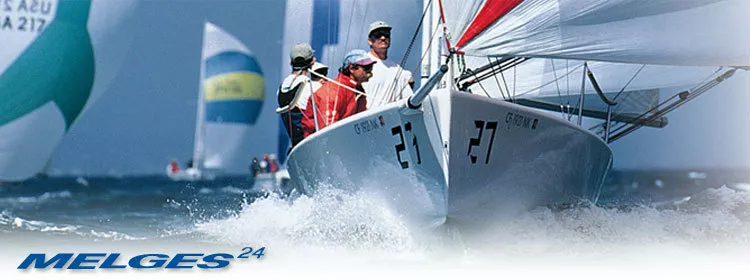
The 5:1 mainsheet system uses a combination of T2 and Carbo blocks. Both 57 mm T2 blocks hang from Dyneema® strops on the boom. A 57 mm Carbo double mounts on the traveler car. A 75 mm switchable Carbo ratchet mounted on a centrally-located 144 swivel base is the workhorse of the system' allowing the skipper to turn the ratchet off in light air or keep it engaged when holding power is needed.

The M24 jib was designed with vertical battens allowing the sail to roll up evenly around the Small Boat furler when sailing downwind or when launching or hauling the boat. The furling drum is set just below deck level' lowering tack height for maximized sail area. An upper swivel is attached to the mast with a T-Ball fitting. The headstay runs up the luff of the jib and attaches to the bottom of the swivel.
Spin Blocks
For quick asymmetrical spinnaker jibes and take downs' M24 sailors use a 75 mm Carbo Ratchamatic cheek block as the last control block before the trimmer. A strong, lightweight Carbo T2 Loop soft-attach block is mounted aft' providing maximum articulation. The Ratchamatic block is load sensing' so when the sheet is dumped through the jibe' the block free-spins without any drag. When the kite fills on the new tack' the ratchet engages' providing the trimmer with 15:1 holding power.
If you would like to link to or reprint this article please contact [email protected]
Class History
The Melges 24 is a turbo-charged one-design that features many high-tech components including a carbon spar, bowsprit, and vertical keel fin. With minimum weight above and maximum weight below, this popular International racer is easy to rig and an exacting platform in all conditions.
Links Melges 24 Class Melges Performance Sailboats McLube™
Boat Specifications
Length: 24 ft (7.82 m) Beam: 8 ft 2 in (2.499 m) Draft: 5 ft (1.52 m) Weight: 1,783 lb (809 kg) Main: 264 sq ft (21.0 sq m) Jib: 126 sq ft (12.0 sq m) Spinnaker: 670 sq ft (55.9 sq m)

Related products

38mm Wire Block

22mm High-Load 1250 Car — Pivoting Toggle

40mm T2™ Loop Soft-Attach Block

57mm Double Block — Swivel

57mm T2™ Soft-Attach Block

57mm T2™ Loop Soft-Attach Block

75mm Cheek Ratchamatic® Block

75mm Ratchet Block — Swivel

High-Load Furling Drum — 5mm Luff Wire

Standard Cam-Matic® Cleat - 150

Standard Cam Base — Swivel
Product categories.
- United States
- New Zealand
- United Kingdom

Croatian Team Razjaren Dominates the Opening Day of the Melges 24 Sailing Series 2024 in Trieste
19 April 2024—Trieste, Italy - The racecourse of the Yacht Club Adriaco in Trieste set the stage for an exhilarating start to the Melges 24 Sailing Series 2024 . With perfect conditions boasting an average wind speed of 12 knots from the west, sailors were treated to a thrilling showcase of skill and competition.
Leading the fleet after an impressive display of prowess is the Croatian entry of Lukasz Podniesinski, Razjaren , helmed by the talented Ante Cesic . Despite a modest start with a sixth-place finish in the initial race, Cesic and his crew rallied with an exceptional trio of first-place victories, establishing a commanding position atop the overall standings.
Ante Cesic , the helmsman of Razjaren : "Today was an intense day on the water with four races pushing our limits. While we had a slow start in the first one, we quickly adjusted our strategy and unleashed our true potential. Three commanding victories followed, It was all about controlling the competition and finishing the job with precision."
In close pursuit is the renowned Zhik Race Team from Britain, led by Miles Quinton , and steered by Geoff Carveth . The team delivered a strong performance with consistent placements, securing second place with just a four-point gap behind the provisional leader.
Making waves among the Italian contingent is the esteemed Strambapapà , skippered by Michele Paoletti, the reigning European and Italian champion. Paoletti graciously handed over the reins to a group of promising local sailors for this event led by Leonardo Centuori , demonstrating the spirit of mentorship within the sailing community. Despite the change in leadership, Strambapapà showcased its strength, claiming third place in the standings.
Rounding out the provisional top five are the dynamic Arkanoè skippered by Sergio Caramel , and the formidable Chinook led by Akos Csolto from Hungary, each demonstrating remarkable skill and determination on the water.
The Melges 24 Sailing Series 2024 promises to deliver a thrilling season of competition, camaraderie, and sportsmanship. As the action unfolds over the coming days, the fans can expect more thrilling races and captivating performances from the world's top Melges 24 sailors.
The first warning signal for the second day will be given on Saturday at noon.
Provisional Results after 4 races Event website & Notice Board Day 1 photos © YCA / ITA M24 Class / Alberto Lucchi
For more information about the Melges 24 European Sailing Series, please visit https://www.melges24.com/europeansailingseries
#melges24 #m24ess
SOCIAL MEDIA:
Yacht Club Adriaco Instagram Yacht Club Adriaco Facebook Italian Melges 24 Class Instagram
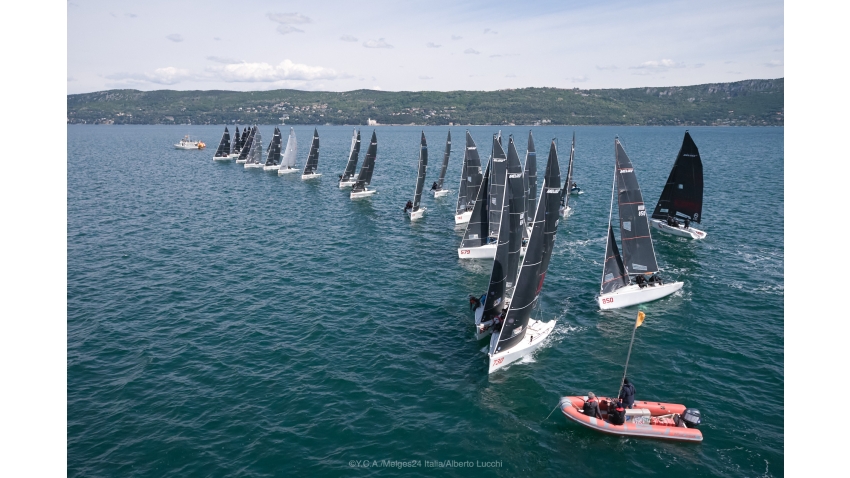
Melges 24 European Sailing Series 2024 in Trieste, Italy
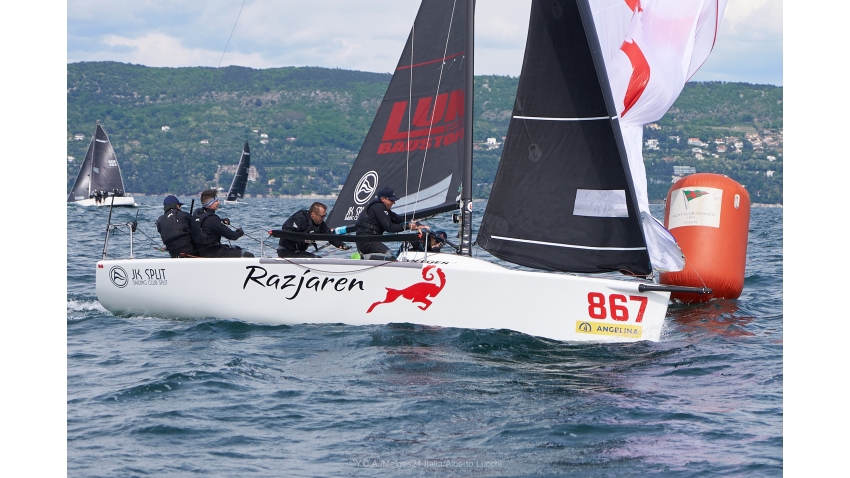
Razjaren (CRO) of Lukasz Podniesinski with Ante Cesic at the helm - Melges 24 European Sailing Series 2024 in Trieste, Italy
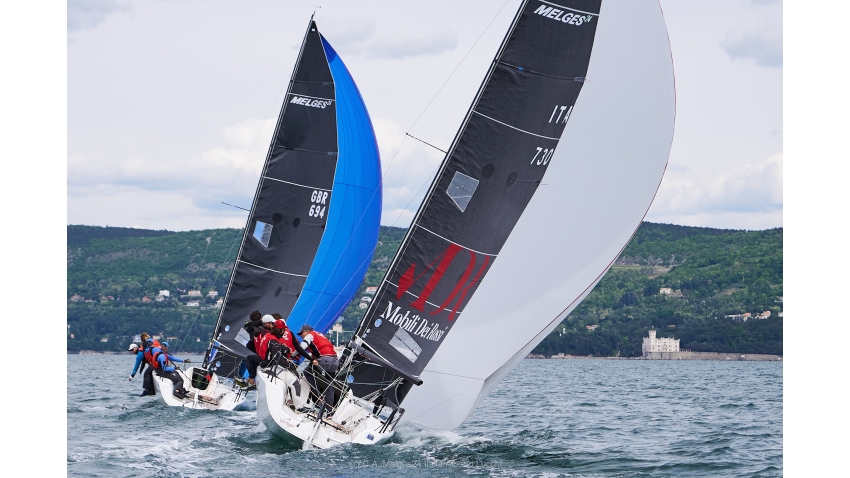
Zhik Race Team (GBR694) of Miles Quinton, steered by Geoff Carveth - Melges 24 European Sailing Series 2024 in Trieste, Italy
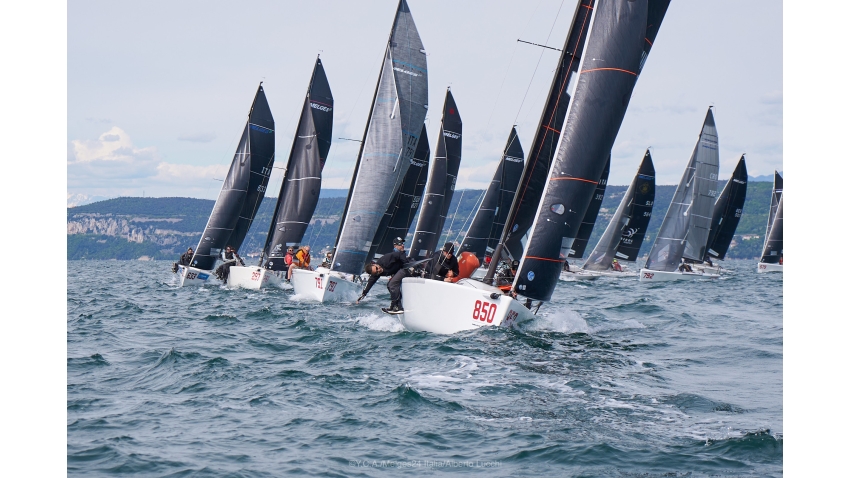
Chinook (HUN850) of Akos Csolto - Melges 24 European Sailing Series 2024 in Trieste, Italy
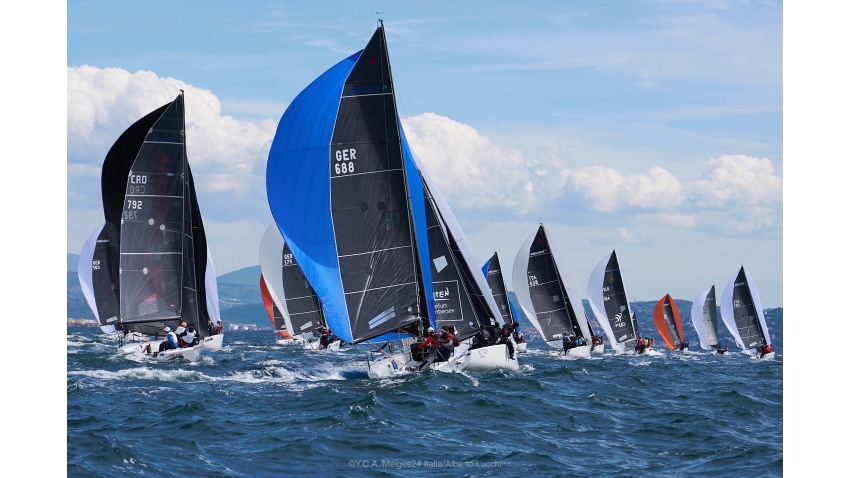

IMAGES
VIDEO
COMMENTS
LENGTH: Traditionally, LOA (length over all) equaled hull length. Today, many builders use LOA to include rail overhangs, bowsprits, etc. and LOD (length on deck) for hull length. That said, LOA may still mean LOD if the builder is being honest and using accepted industry standards developed by groups like the ABYC (American Boat and Yacht Council).
The Melges 24 is a racing keelboat, built predominantly of fiberglass. It has a fractional sloop rig with a deck-stepped carbon fiber mast. The hull has a nearly-plumb stem, an open reverse transom, a transom-hung rudder controlled by a carbon fiber tiller with an extension and a retractable lifting keel with a weighted bulb. It displaces 1,750 ...
A measure of the stability of a boat's hull that suggests how well a monohull will stand up to its sails. The ballast displacement ratio indicates how much of the weight of a boat is placed for maximum stability against capsizing and is an indicator of stiffness and resistance to capsize. Formula. 37.15. <40: less stiff, less powerful.
0. If sailboats were defined in human terms, the Melges 24 could easily be described as having the attributes of a precocious three-year-old who hadn't learned to respect her elders. More than likely, she also would be described as being gifted, if a little high strung. Melges 24 Specifications. Introduced as a prototype at Key West Race Week ...
The Melges 24 is a 24.0ft fractional sloop designed by Reichel/Pugh and built in fiberglass by Melges Performance Sailboats since 1993. The Melges 24 is an ultralight sailboat which is a very high performer. It is stable / stiff and has a low righting capability if capsized. It is best suited as a racing boat.
THE MELGES 24. The reputation of the Melges 24 ® precedes itself. Best known for its very competitive disposition and easy-to-sail personality, this modern sportboat maintains its status as a leader in high-performance, one design sailing. Coming off his America's Cup win, Buddy Melges had an obvious desire to take one-design racing to the ...
The Melges 24. The reputation of the Melges 24 ® precedes itself. Best known for its very competitive disposition and easy-to-sail personality, this modern sportboat maintains its status as a leader in high-performance, one design yachting. A simplistic, rocket-like approach to speed and world-class competition makes it the ultimate racer.
World Sailing - Melges 24. A high-performance keelboat with a carbon mast and an asymmetric spinnaker. Find out more about this thrilling and competitive class.
Sailboat specifications. Last update: 20th March 2020. The Melges 24 is a 24' (7.32m) one design sailboat designed by Reichel/Pugh Yacht Design (United States). She is built since 1993 by Melges (United States) and Devoti Sailing (Czech Republic).
THE BOHO'S WIN MELGES 24 MIDWINTERS AND OVERALL TITLE IN ST. PETE. By Dave Reed, February 18, 2024 - Steve and Catherine Boho, owners of the Melges 24 The 300, had some mild trepidations about racing on the final day of the Helly Hansen Sailing World Regatta Series in St. Petersburg.As they stepped out of their hotel and into the heavy rain and the brisk north wind in the morning, they knew ...
The reputation of the Melges 24 ® precedes itself. Best known for its very competitive disposition and easy-to-sail personality. This modern sportboat maintains its status as a leader in high-performance, one design sailing. The Melges 24 is a lifestyle with competitive racing and a focus on fun. This America's Cup inspired boat generates ...
Born in the U.S.A., the Melges 24. by U.S. Melges 24 Class Association 23 Mar 2023 11:29 PDT. You have to love those hearty Midwesterners. This photo shows the Melges 24, hull no. 1, being launched for the first time on Lake Geneva in the snow. Among those pictured are Buddy, Harry and Hans Melges, Billy Freytag, Brian Porter and John Porter ...
The Melges 24 is by far the most unique one design sportboat in the world and to this day maintains a growing and vibrant class. There is no comparison. The response and excitement generated by this America's Cup inspired boat is phenomenal. Typically sailed with a crew of 4, the Melges 24's comfortable, light-hull displacement design ...
The Melges 24 is a great boat if you like to be active when you sail. It requires athleticism, but not brute strength. The loads are not that high and there are no winches—ratchet blocks only. You have to hike hard, but since the class changed to shorter stanchions and tighter lifelines, hiking is less painful.
Complete Sail Plan Data for the Melges 24 Sail Data. Sailrite offers free rig and sail dimensions with featured products and canvas kits that fit the boat. ... Sailboat Data ; Melges 24 Sail Data ; Melges 24 Sail Data. Pinit. SKU: X-SD-4583 . Quantity discounts available . Quantity Price; Quantity -+ Add to Cart . You may also like. Anchor ...
Sailboat data, rig dimensions and recommended sail areas for Melges 24 sailboat. Tech info about rigging, halyards, sheets, mainsail covers and more. Sailboat Data directory for over 8,000 sailboat designs and manufacturers. Direct access to halyards lengths, recommended sail areas, mainsail cover styles, standing rigging fittings, and lots ...
24.03.2021. March 24, 2021 - IM24CA - After reviewing the proposals to amend the Melges 24 Class Rules submitted by the World Council of the International Melges 24 Class Association, World Sailing has approved changes to the Melges 24 Class Rules on March 17 and has published them on March 24. A new edition of the Melges 24 Class Rules 2021 ...
The racecourse of the Yacht Club Adriaco in Trieste set the stage for an exhilarating start to the Melges 24 Sailing Series 2024. With perfect conditions boasting an average wind speed of 12 knots from the west, sailors were treated to a thrilling showcase of skill and competition. Leading the fleet after an impressive display of prowess is the ...
The Melges 24 builds better sailors. LEARN MORE . MELGES 20. Simple, fun world-class racing at yachting's most celebrated venues. Corinthians and professionals alike. Year after year, that's what the Melges 20 Experience is all about. The Melges 20 fulfills the need for a more compact, yet spacious, fast, well-built sportboat. With its ...
Class History The Melges 24 is a turbo-charged one-design that features many high-tech components including a carbon spar, bowsprit, and vertical keel fin. With minimum weight above and maximum weight below, this popular International racer is easy to rig and an exacting platform in all conditions. LinksMelges 24 ClassMelges Performance SailboatsMcLube™ Boat Specifications Length: 24 ft (7. ...
19 April 2024—Trieste, Italy - The racecourse of the Yacht Club Adriaco in Trieste set the stage for an exhilarating start to the Melges 24 Sailing Series 2024.With perfect conditions boasting an average wind speed of 12 knots from the west, sailors were treated to a thrilling showcase of skill and competition.